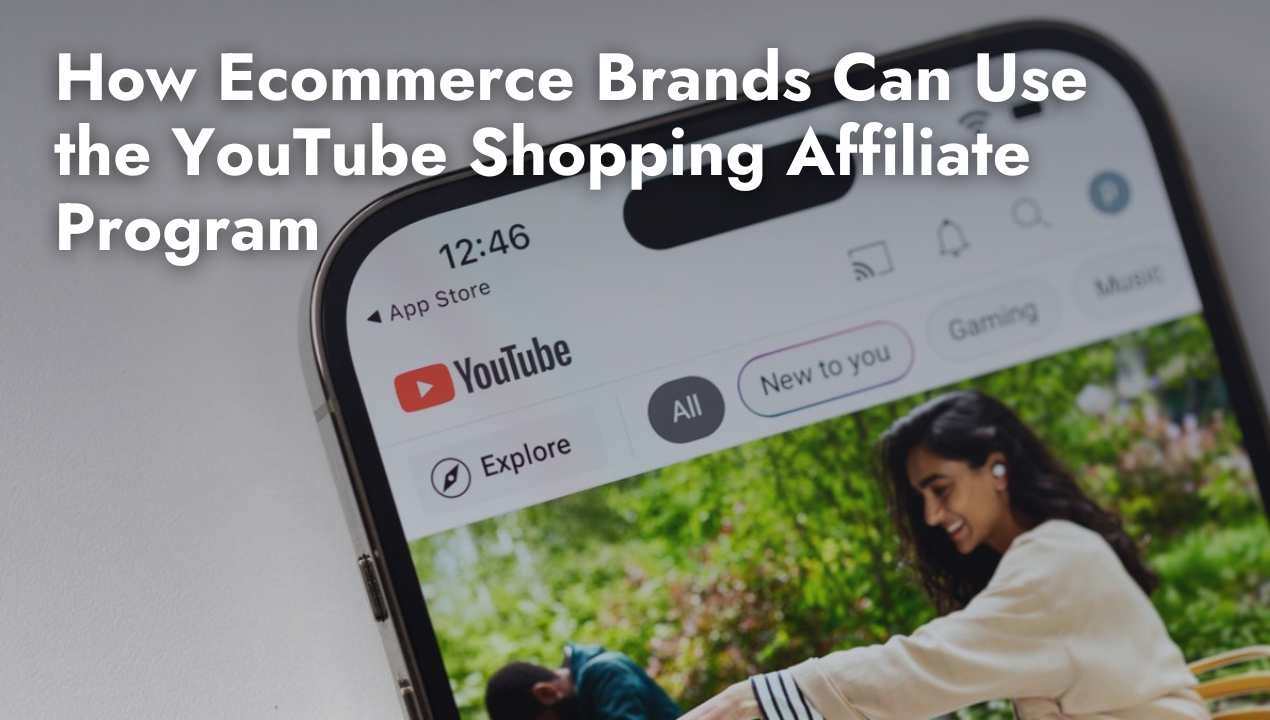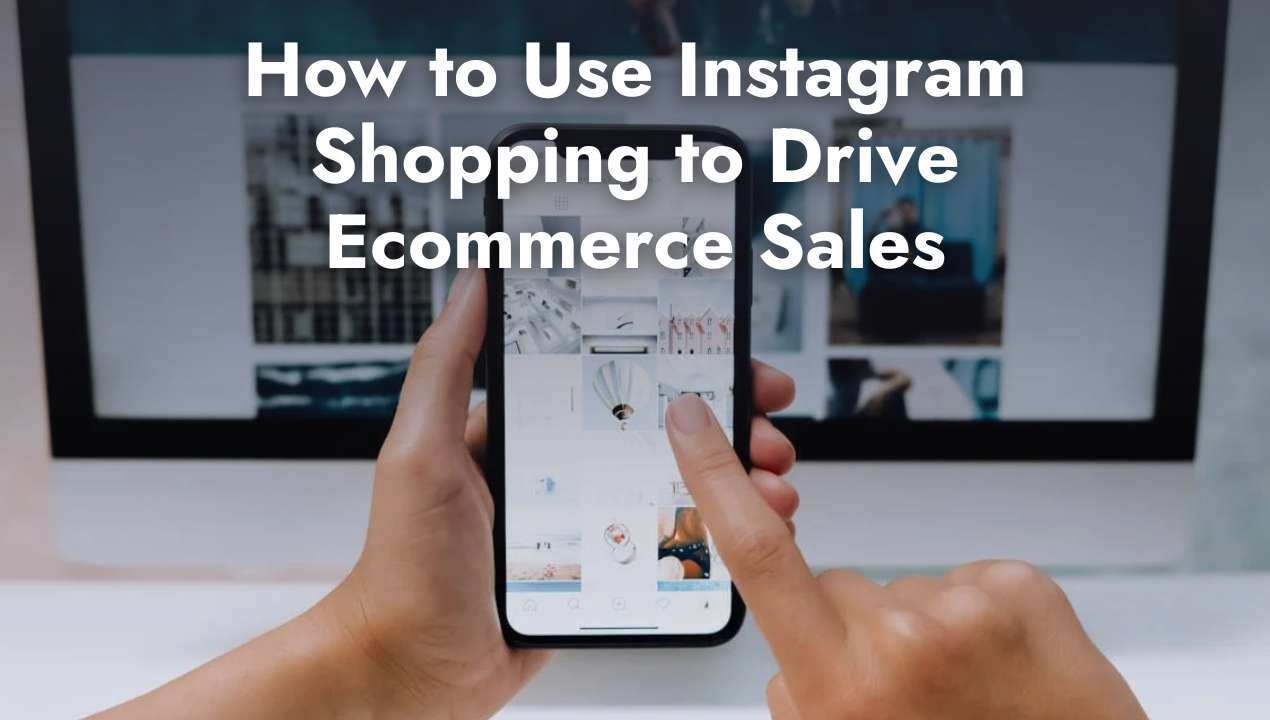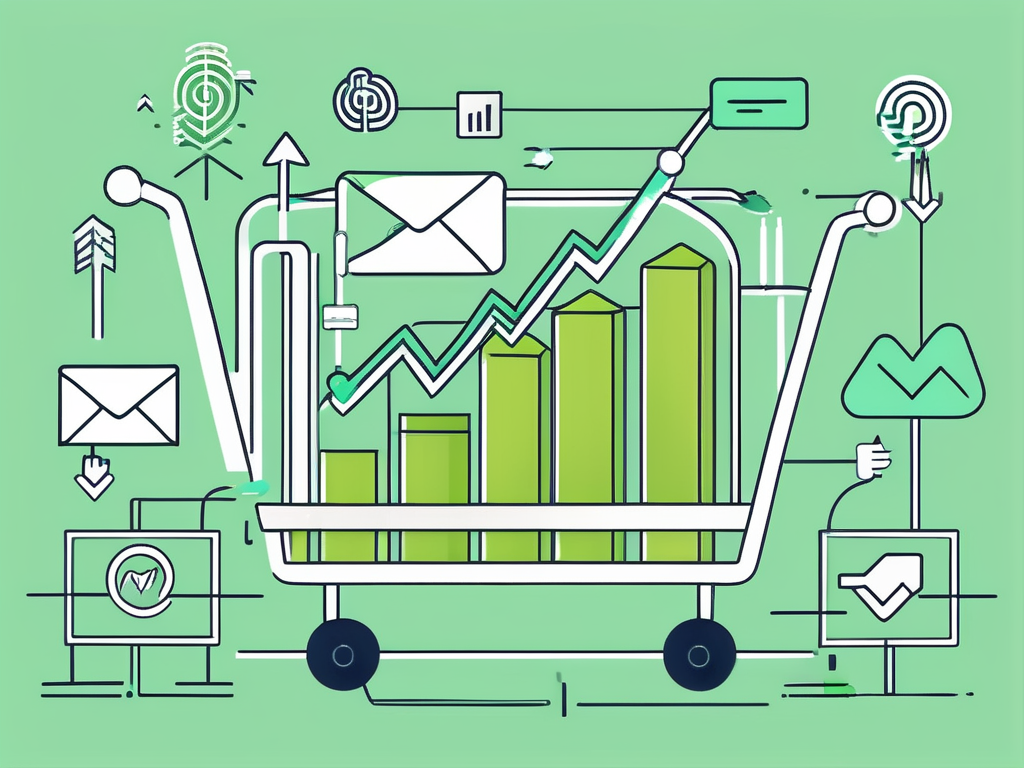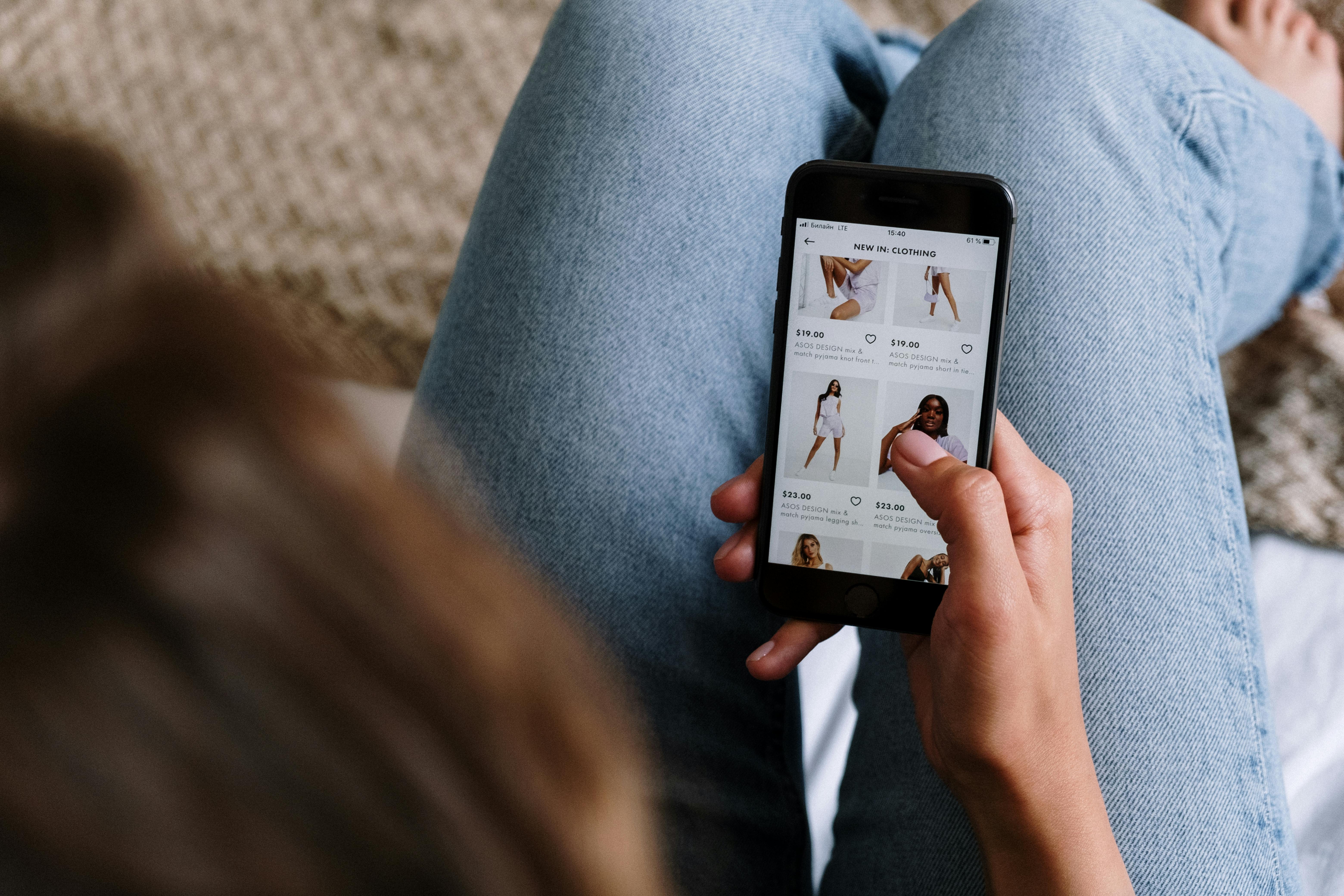Share this
How Ecommerce Brands Can Use the YouTube Shopping Affiliate Program
by Rin Mosher on Feb. 6, 2025

They say “time is money”. If that’s true, 30 billion hours of shopping-related videos consumed per year make YouTube Shopping a gold mine for ecommerce brands. Well, that and plenty of built-in marketing tools; from the YouTube Shopping Affiliate Program to in-video features, the social commerce platform is rich in opportunities for product promotion, brand awareness, and sales. You just need to know where to find – and how to make the most of – each one.
We’ll offer guidance on doing just that in this guide. Read it to find out what strategies and resources businesses are using to turn everyday users into paying customers on this video-centric ecommerce sales channel.
How Ecommerce Brands Use YouTube Shopping as a Sales Channel
YouTube is no longer just a place for individuals and businesses to create topic-based videos and run related ads. Now, there’s an entire ecosystem specifically designed for product discovery and sales. YouTube Shopping weaves elements of ecommerce into the user experience through integrated ecommerce features that capitalize upon interest in the moment.
YouTube Shopping is a great TikTok Shop alternative because the two are similar in many ways. Businesses can upload products, and if they’re set up with Shopify, set up in-app checkout to allow viewers to purchase products without leaving the platform. The expansion represents a lucrative opportunity on what was once only a marketing platform. Instead of only paying for promotional opportunities like ads, there’s now a way brands can earn direct sales revenue from their presence on YouTube – and that’s setting up a YouTube Shopping store.
What Is the YouTube Shopping Affiliate Program?
Product feature tools are just the beginning when it comes to opportunities for exposure and sales on YouTube Shopping. Many brands find success showcasing products through the YouTube Shopping Affiliate Program, an in-platform network launched in 2023 as a formal space for promotional partnerships between creators and businesses.
The concept is simple: YouTube Shopping store owners search for creators who align with their ethos and audience. An intuitive dashboard highlights potential partners based on content relevance, viewer demographics, and other metrics. Once a match is found, both parties can negotiate terms that benefit each side. Brands set their own flat or multi-tiered commission offers, which usually fall between 5% and 20% of a product’s purchase price, and pay creators via their existing YouTube account for every sale generated.

Not everyone can join the YouTube Shopping Affiliate Program, though. Accounts must be based in the United States and meet several qualification criteria in order to apply as a creator or ecommerce business.
To apply as an ecommerce business, you'll need:
- A Shopify Advanced or Plus subscription plan
- The Google & YouTube app connected to your Shopify store and Google Merchant Center account
- Conversion tracking and auto-tagging turned on in account settings
- Your store's currency set to US dollars
- A billing address in the United States
- To follow Google Merchant Center guidelines
Creators, meanwhile, are quality-controlled by the following parameters:
- Membership in the YouTube Partner Program
- More than 10,000 channel subscribers
- Based in the United States, South Korea, Indonesia, India, Thailand, or Vietnam
- An audience that isn’t set as Made for Kids
Other Ways Ecommerce Businesses Can Use YouTube for Marketing
The YouTube Shopping Affiliate Program is just one of many ways ecommerce businesses can drive sales through content and creator partnerships on YouTube.
Commission-Based Partnerships
Commission-based partnerships are the most common kind between affiliates and brands. In one, the creator or 'contractor' promotes products in exchange for a percentage of the profit generated from each sale. Online platforms provide plenty of ways to track attribution, although links are the most common tool used. Unique URLs record conversions from audiences after they've clicked on a specific creator's CTA. Discount codes work in a similar way, being unique to each affiliate while offering an extra incentive for shoppers.
Affiliates on YouTube may accept solely commission-based arrangements or require a base fee in addition to a percentage of every sale. In the first case, payment hinges on performance. That works well for businesses that aren't yet ready to commit to upfront costs. For creators, it can be a gamble, but a lucrative one if their audience is engaged and responsive.
Conversely, a base fee ensures some compensation regardless of sales, providing a safety net for the affiliate. Balancing these options depends on the brand's budget and the influencer's confidence in their selling power.
Commission-based partnerships can be arranged through the YouTube Shopping Affiliate Program or externally between a business and contractor. Well-established terms and tracking systems ensure both parties receive their expected return.
Gifting and Unboxing Content
Product gifting and unboxing content is especially relevant to ecommerce brands hoping to reach their target audience on YouTube. Although some exchange of money usually takes place, the strategy primarily involves sending products to influencers with the intention of having them open or talk about those items in a feature video as promotional content. Unboxing videos make for particularly loyalty-building exposure as viewers experience the excitement of discovering new products alongside creators they trust for an honest opinion.
Businesses can also ship PR kits and product samples to influencers hoping for organic, authentic reactions. Most high-profile creators take inquiries through a dedicated manager or agency. Otherwise, the only way to reach prospects is by emailing them directly or looking to see if their PO box is listed anywhere online.
This strategy comes with risks; there’s a chance of the influencer not liking what they receive or declining to make a video at all. Yet there are success stories as well. In one notable example, Korean skincare brand CosRX gained significant traction on YouTube after sending their snail mucin essence to beauty influencers — some without any strings attached. They've now been studied as a blueprint for market expansion through strategic gifting.

Collaborations and Sponsorships
You've surely seen brand collaborations before - Louis Vuitton x Supreme, LEGO x Adidas, and Peeps x Pepsi offer just a few high-profile examples. But these promotional partnerships don't have to be between two “company” brands. High-profile creators with personal brands often lend their name and likeness to campaigns through exclusive product lines and sponsored content. Take Daniel Arsham x Heinz, for instance. This collaboration combined a contemporary artist's vision with an iconic household name in everything from autographed cans to t-shirts.
Product collaborations and sponsorships can take various forms on YouTube, depending on the influencer's niche and the brand's goals. For instance, a tech influencer might work with a gadget company to launch a new line of phone cases, while a fashion vlogger could co-design a clothing collection with a retailer. But ecommerce brand collaborations don’t have to be a tangible product; smaller businesses can also gain game-changing visibility and credibility from co-created content.
This ventures into the territory of sponsorships, which is when brands pay creators for a moment of spotlight in their “regular programming”. Paid plugs may be cheaper than collaboration campaigns but can come off as less authentic.
At the same time, full collaborations require significant planning; partners must decide not only what they want to create together, but also who will take responsibility for what aspects of video production, on which channels that content will be posted, and when. Those large investments of time, money, and energy only pay off when both sides are clear on their respective responsibilities.
Account Takeover Agreements and Events
In some scenarios, brands let YouTube creators take the reins of their entire marketing campaign with an account takeover or event. Account takeovers can be a one-time event or span several days, depending on the campaign's goals. They often involve live streams, Q&A sessions, or behind-the-scenes content that showcases the brand in a new light.
Events, on the other hand, might include product launches, special announcements, or interactive experiences that invite audience participation.
Both approaches offer a fresh perspective and can generate significant buzz, especially when aligned with a well-timed marketing push. However, they require careful planning and trust, as the brand's reputation is in the influencer's hands.
What Makes a Good YouTube Shopping Affiliate Campaign?
Just like how a business’ product is only as profitable as its go-to-market strategy, YouTube Shopping affiliate marketing campaigns require thoughtful planning in order to work. Success isn't necessarily guaranteed by paying for exposure; while a large audience size can help, aligned values between the brands, affiliates, and follower communities make the biggest impact on results.
Before starting your search, reflect on the following.
Audience Engagement
Look for creators whose comment sections show active discussions and thoughtful responses from the creator. Strong engagement typically means:
- Comment-to-view ratios above 2%
- Consistent viewer participation in polls and community posts
- Active comment responses from the creator within 24-48 hours
- Meaningful discussions beyond simple emoji reactions
Content Quality
Assess technical and presentational aspects such as:
- Clean, well-lit video footage with clear audio
- Structured content with clear introductions and conclusions
- Professional thumbnails and consistent branding
- Regular posting schedule (minimum bi-weekly uploads)
- Well-researched content with cited sources when applicable
Relevance
Verify alignment through:
- At least 60% of content focuses on your industry or related topics
- Audience demographics match your target market
- Creator has demonstrated product knowledge in your category
- Content style matches your brand voice (educational, entertaining, etc.)
Authenticity
Look for creators who:
- Include balanced reviews with both pros and cons
- Maintain transparency about sponsored content
- Show consistent personal values across their content
- Have a genuine backstory or expertise in your niche
- Limit sponsored posts to no more than 30% of their content
Past Collaborations
Evaluate their track record by:
- Reviewing their "sponsored" playlist if available
- Checking for long-term partnerships (repeat collaborations)
- Looking for integration quality in previous sponsored content
- Researching their reputation among other brands
- Verifying they haven't worked with direct competitors recently
Communication Skills
Assess professionalism through:
- Response time to initial outreach (within 1-2 business days)
- Clarity in discussing deliverables and expectations
- Ability to provide a professional media kit
- Willingness to sign and understand contracts
- Experience working with proper disclosure requirements
Flexibility
Look for creators who demonstrate:
- Experience with multiple content formats (long-form, shorts, live streams)
- Willingness to create custom content types for your brand
- Ability to adapt to feedback and make revisions
- Open to collaborative ideation
- History of testing new YouTube features and trends
How to Find YouTube Shopping Affiliates for Your Ecommerce Business
You can go about finding influencers for YouTube marketing partnerships in a couple of ways. Many businesses find it easiest to start their search on BrandConnect, YouTube's own network of creators for hire. Here's everything you need to know about it and other avenues of partner discovery.
BrandConnect (Formerly FrameBit)
This platform became part of the YouTube ecosystem in 2018 when YouTube acquired the company to streamline influencer partnerships. It offers tools for campaign management, analytics, and payment processing, all within the same system businesses already use to manage their YouTube Shopping channels.
Third-Party YouTube Influencer Marketing Networks
BrandConnect promises extra convenience and credibility through its direct integration with YouTube. However, partnerships between businesses and creators can happen in lots of places outside this in-platform network. Several third-party websites, online communities, and agencies exist for the same purpose.
Well-established alternatives include:
- Brandwatch Influencer Marketing Software
- Sprout Social
- Creator.co
- Modash
Which one is best? It ultimately comes down to goals and budget. You may end up sourcing talent from multiple YouTube Affiliate networks or find better luck with the option we present next.
Research, Direct Outreach, and Networking
Sometimes, the best way to find the right YouTube affiliates is through direct outreach and networking. That means taking on the job BrandConnect, Brandwatch, and other platforms are meant to facilitate on your own. But it can prove worthwhile for those who have somewhere to start from.
For instance, you might already be aware of possible candidates or have a strong personal network. Reaching out directly can establish more personalized connections, which might lead to more fruitful collaborations.
Social media platforms and online communities are treasure troves for discovering potential YouTube affiliates. Explore influencer content on platforms like Instagram, Twitter, or LinkedIn through hashtags related to your market. Look through an average customer's 'Following' list for names that pop up often. Then, it's simply a matter of vetting and reaching out to them directly.
How to Make Sure Your YouTube Shopping Affiliate Marketing Pays Off
Vetting and validation play equally important roles in determining the success of affiliate marketing efforts. From the beginning, you'll need to know that who you're working with is both reliable and true to their claims.
YouTube's Fake Engagement Policy doesn't allow for the artificial increase of views, likes, comments, or other metrics. Creators who engage in such practices put themselves and their partners at risk of removal while delivering less actual ROI. Reputation also matters; brands have faced backlash due to an influencer's controversial behavior prior to or during their engagement together.
You don't need to run an FBI-grade background check but doing a little homework can save a lot of headaches in the long run. There are even agencies specializing in audits for influencer engagement rates, audience demographics, and past collaborations.
Key performance indicators (KPIs) such as click-through rates, conversion rates, and overall sales growth will serve as a guiding compass when assessing past performance and monitoring current campaigns. YouTube Shopping has built-in tools for the job, as do third-party partnership platforms. It's up to you to conduct regular reviews, identify trends, and adjust strategies.
Invest In Top-Notch Fulfillment
YouTube Shopping influencers do the easy part of selling ecommerce products. The real work comes post-checkout — timely shipping, easy returns, and responsive support for customers, no matter how many you have to serve. Third-party logistics (3PL) companies help businesses of all sizes reap the benefits of influencer marketing with fulfillment solutions built to scale.
This is the best way to ensure your partnerships pay off in full and remain sustainable over the long term.
YouTube Shopping Affiliate Program Success Starts with Shipfusion
Ready to put the above knowledge into action and execute your own YouTube Shopping marketing strategy? Great. Just remember part of that planning should consider what comes after. Success on this and every other ecommerce sales channel is contingent on fulfilling orders on time and as expected.
Luckily, when you choose Shipfusion as a third-party logistics partner, you’re working with a service provider that not only meets industry standards but exceeds expectations. Our team’s 99.9% effectiveness in meeting SLAs empowers businesses to maintain operational excellence no matter how fast they scale. Take on YouTube Shopping with confidence knowing an entire network of warehouses and on-site, dedicated Account Managers will be there no matter what.
Let’s talk solutions – reach out to a fulfillment specialist today.
Share this
You May Also Like
These Related Articles

How to Use Instagram Shopping to Drive Ecommerce Sales

How to Increase Conversions: Proven Strategies for Success

The Best Social Commerce Platforms In 2024 with Benchmarks
- April 2025 (18)
- March 2025 (26)
- February 2025 (26)
- January 2025 (37)
- December 2024 (16)
- November 2024 (23)
- October 2024 (22)
- September 2024 (27)
- August 2024 (9)
- July 2024 (8)
- June 2024 (5)
- May 2024 (8)
- April 2024 (8)
- March 2024 (6)
- February 2024 (6)
- January 2024 (5)
- December 2023 (3)
- November 2023 (3)
- October 2023 (5)
- September 2023 (4)
- August 2023 (2)
- July 2023 (1)
- June 2023 (4)
- March 2023 (2)
- October 2022 (1)
- September 2022 (5)
- August 2022 (4)
- July 2022 (7)
- June 2022 (4)
- May 2022 (4)
- April 2022 (6)
- March 2022 (2)
- February 2022 (1)
- January 2022 (3)
- December 2021 (2)
- November 2021 (4)
- October 2021 (2)
- September 2021 (5)
- August 2021 (4)
- July 2021 (4)
- June 2021 (3)
- May 2021 (2)
- April 2021 (3)
- March 2021 (3)
- February 2021 (3)
- January 2021 (2)
- December 2020 (4)
- November 2020 (2)
- October 2020 (4)
- September 2020 (2)
- July 2020 (5)
- June 2020 (4)
- May 2020 (2)
- April 2020 (2)
- March 2020 (4)
- February 2020 (1)
- December 2019 (1)
- May 2018 (1)
- March 2018 (2)
- February 2018 (3)
- January 2018 (3)
- November 2017 (3)
- July 2017 (4)
- March 2017 (3)
- February 2017 (5)
- January 2017 (3)
- December 2016 (4)
- November 2016 (6)
- October 2016 (6)
- October 2015 (1)
- September 2015 (1)
- June 2015 (3)
- May 2015 (3)
- August 2014 (1)
- July 2014 (1)
- March 2014 (1)
- February 2014 (1)